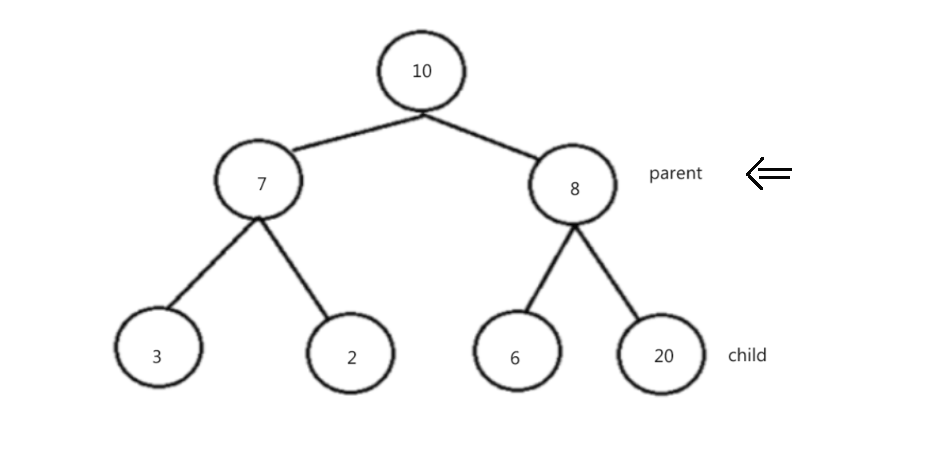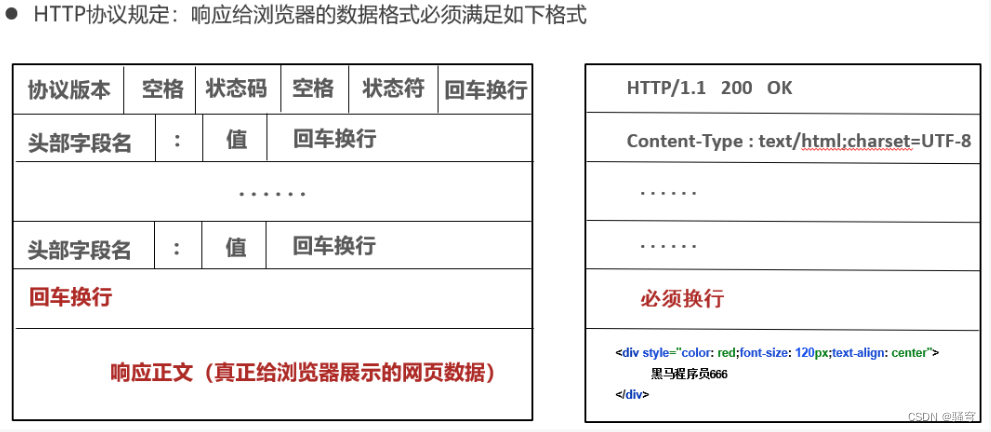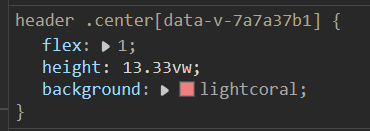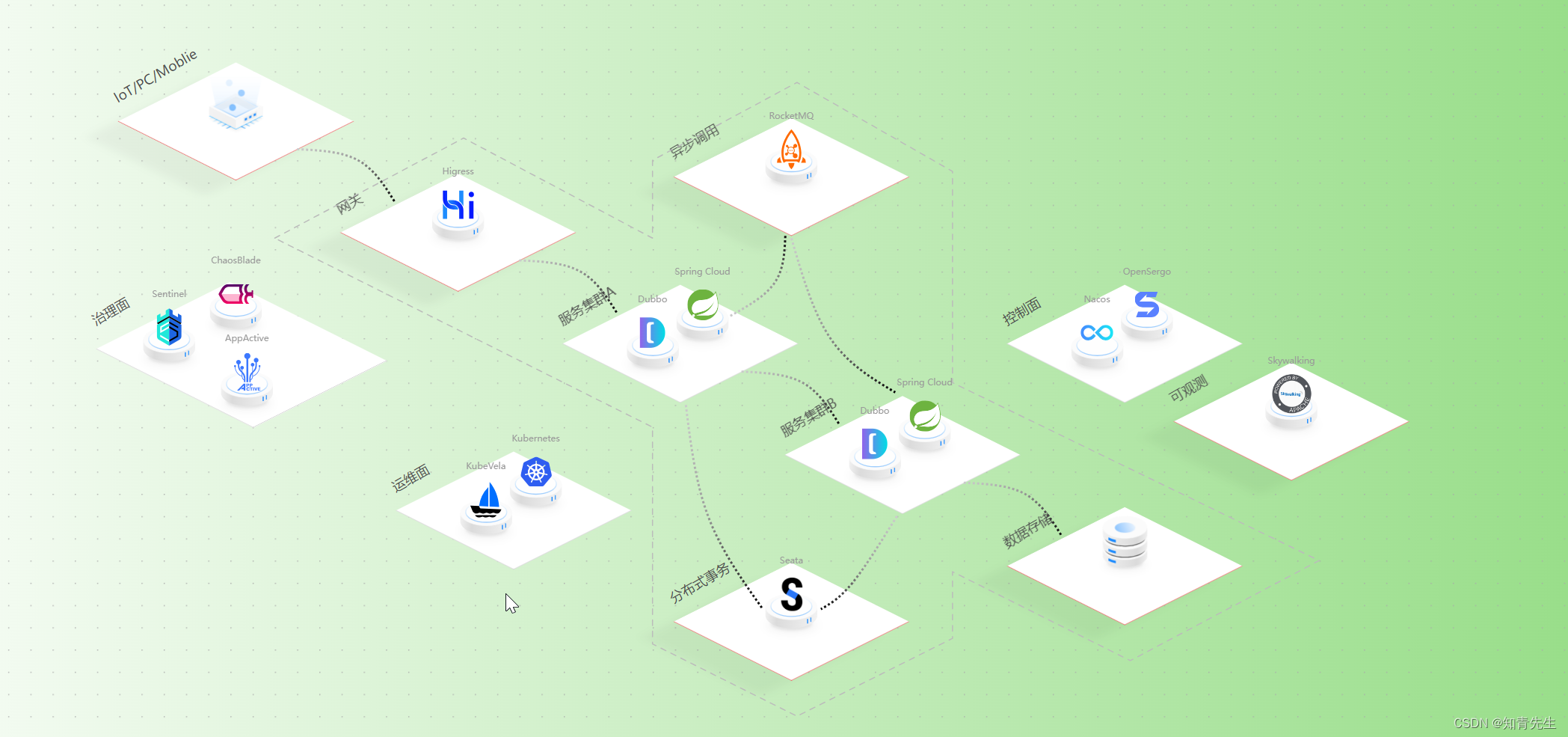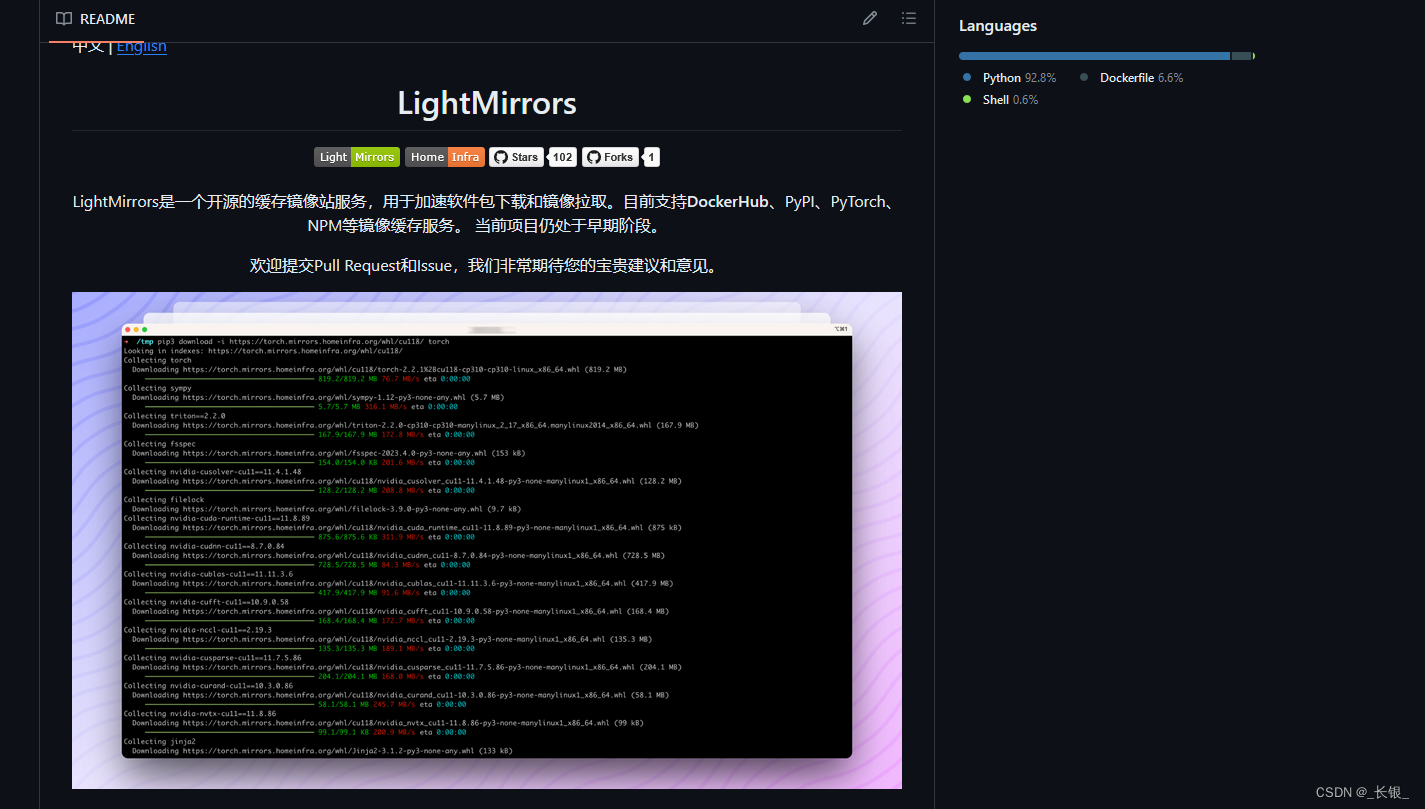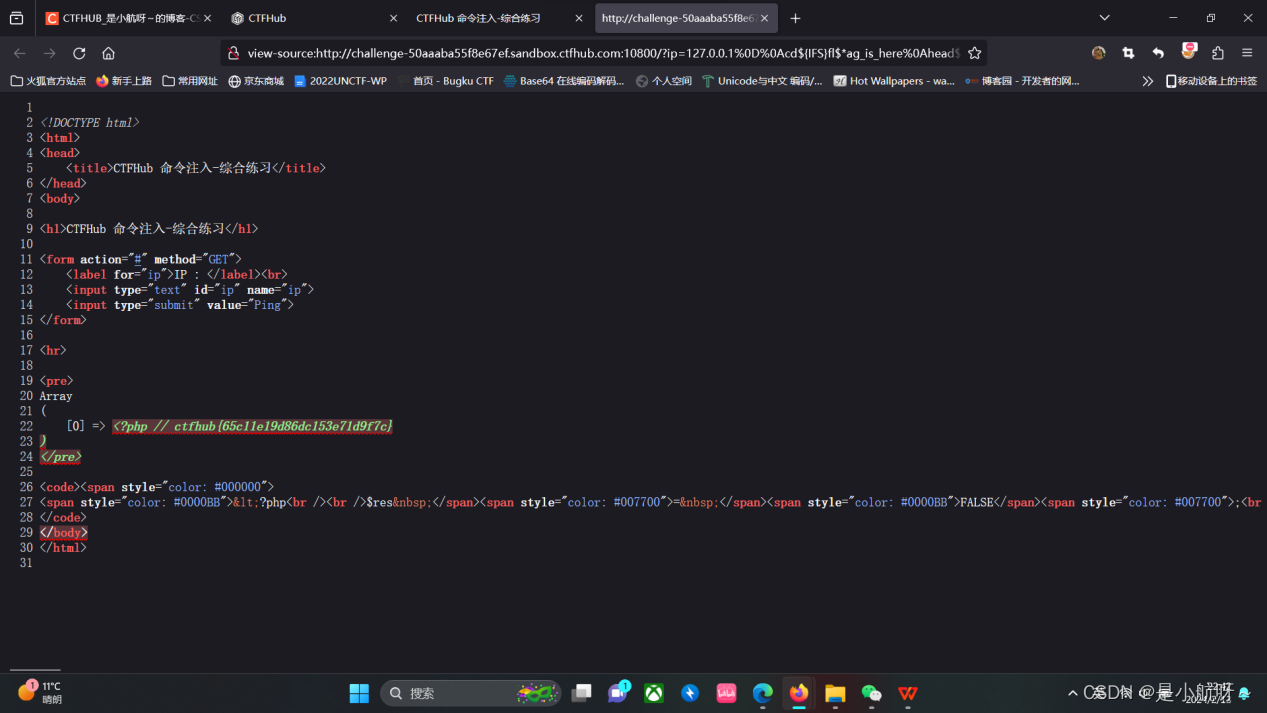1. 在所有其他参数保持不变的情况下,更改超参数num_hiddens的值,并查看此超参数的变化对结果有何影响。确定此超参数的最佳值。
通过改变隐藏层的数量,导致就是函数拟合复杂度下降,隐藏层过多可能导致过拟合,而过少导致欠拟合。
我们将层数改为128可得:
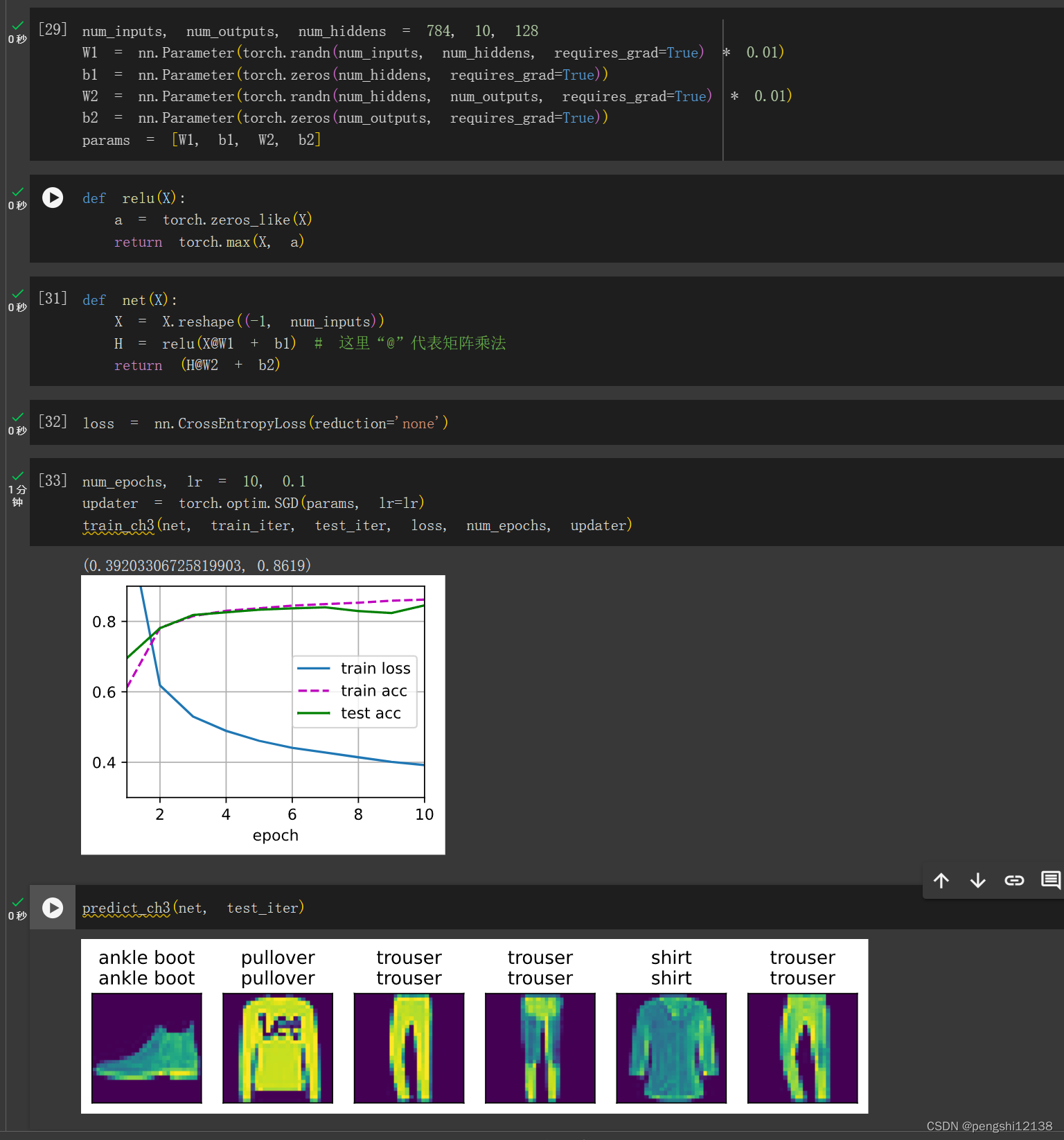
2. 尝试添加更多的隐藏层,并查看它对结果有何影响。
过拟合,导致测试机精确度下降。
3. 改变学习速率会如何影响结果?保持模型架构和其他超参数(包括轮数)不变,学习率设置为多少会带来最好的结果?
过高的学习率导致,梯度跨度过大,使得降低不到对应的驻点。
过低的学习率导致训练缓慢,需要增加epoch。
在训练轮数不变的情况下,我们可以通过for 设置不同的学习率找出最合适的学习率。一般来说设置为0.01或者0.1足以
4. 通过对所有超参数(学习率、轮数、隐藏层数、每层的隐藏单元数)进行联合优化,可以得到的最佳结果是什么?
跑了一次学习率lr=0.01的情况:
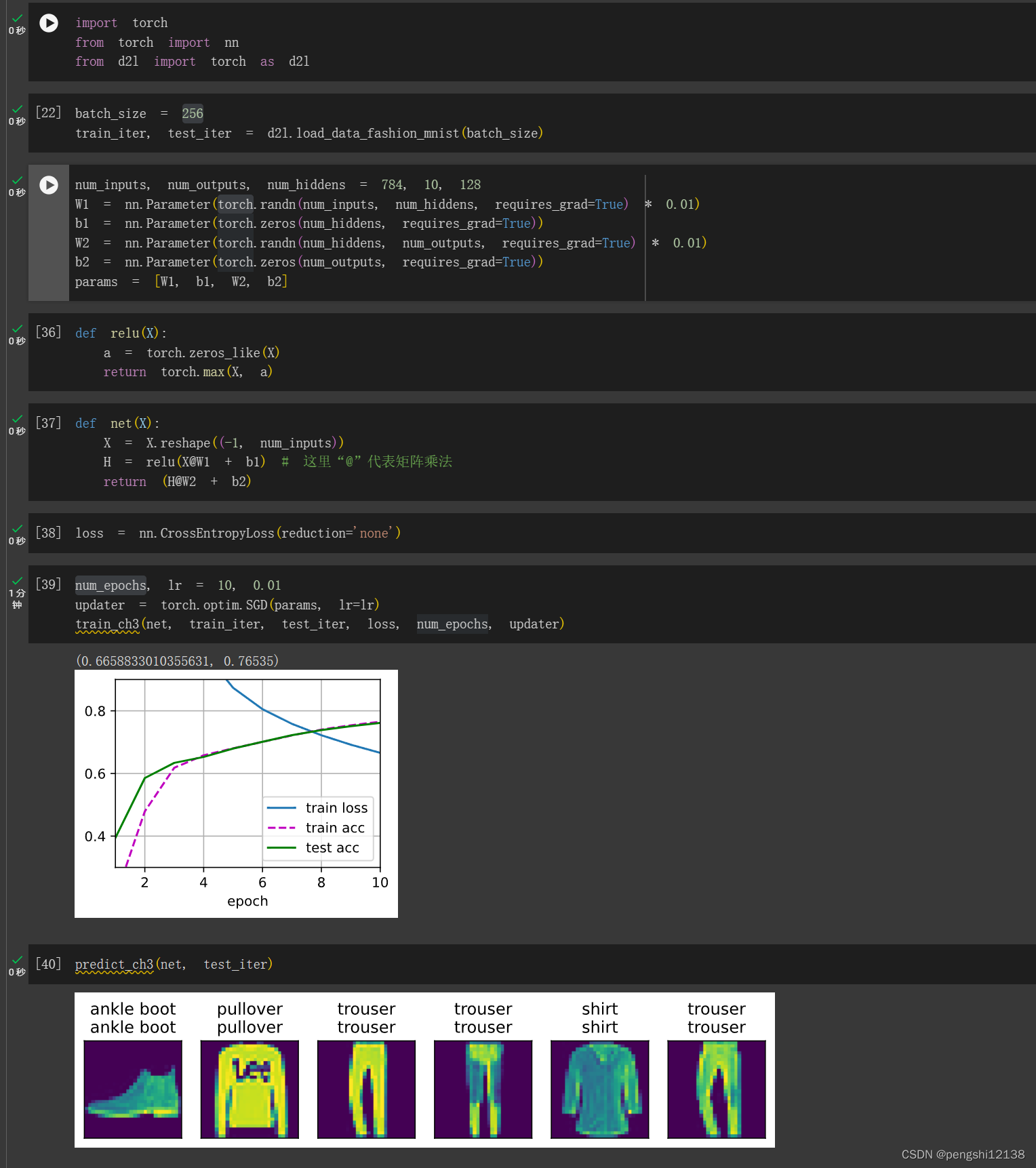
需要大量的训练,但是目前我训练结果是学习率lr=0.1、轮数是num_epochs=10,隐藏层数为1,隐藏层数单元num_hiddens=128。
5. 描述为什么涉及多个超参数更具挑战性。
因为组合的情况更多,当层数越多时,训练时间也更多,这玩意就是炼丹了,看你自己的GPU还有时间、运气。
6. 如果想要构建多个超参数的搜索方法,请想出一个聪明的策略。
套用for 循环暴力破解,时间上肯定慢的要死,我们可以先固定其他变量,挑选一个变量寻找最优解,以此类推对所有的超参数这样使用,但是这种做法肯定不是最优的,只是能够较好的找出比较好的超参数。
由于学校穷逼所以没有闲置GPU服务器,所有的模型只能在colab上进行运行,其中遇到了d2l的版本对应问题,所以对于d2l.train_ch3跑不起来,只能使用自写进行替代如下:
import torch.nn
from d2l import torch as d2l
from IPython import displayclass Accumulator:"""在n个变量上累加"""def __init__(self, n):self.data = [0.0] * n # 创建一个长度为 n 的列表,初始化所有元素为0.0。def add(self, *args): # 累加self.data = [a + float(b) for a, b in zip(self.data, args)]def reset(self): # 重置累加器的状态,将所有元素重置为0.0self.data = [0.0] * len(self.data)def __getitem__(self, idx): # 获取所有数据return self.data[idx]def accuracy(y_hat, y):"""计算正确的数量:param y_hat::param y::return:"""if len(y_hat.shape) > 1 and y_hat.shape[1] > 1:y_hat = y_hat.argmax(axis=1) # 在每行中找到最大值的索引,以确定每个样本的预测类别cmp = y_hat.type(y.dtype) == yreturn float(cmp.type(y.dtype).sum())def evaluate_accuracy(net, data_iter):"""计算指定数据集的精度:param net::param data_iter::return:"""if isinstance(net, torch.nn.Module):net.eval() # 通常会关闭一些在训练时启用的行为metric = Accumulator(2)with torch.no_grad():for X, y in data_iter:metric.add(accuracy(net(X), y), y.numel())return metric[0] / metric[1]class Animator:"""在动画中绘制数据"""def __init__(self, xlabel=None, ylabel=None, legend=None, xlim=None,ylim=None, xscale='linear', yscale='linear',fmts=('-', 'm--', 'g-', 'r:'), nrows=1, ncols=1,figsize=(3.5, 2.5)):# 增量的绘制多条线if legend is None:legend = []d2l.use_svg_display()self.fig, self.axes = d2l.plt.subplots(nrows, ncols, figsize=figsize)if nrows * ncols == 1:self.axes = [self.axes, ]# 使用lambda函数捕获参数self.config_axes = lambda: d2l.set_axes(self.axes[0], xlabel, ylabel, xlim, ylim, xscale, yscale, legend)self.X, self.Y, self.fmts = None, None, fmtsdef add(self, x, y):"""向图表中添加多个数据点:param x::param y::return:"""if not hasattr(y, "__len__"):y = [y]n = len(y)if not hasattr(x, "__len__"):x = [x] * nif not self.X:self.X = [[] for _ in range(n)]if not self.Y:self.Y = [[] for _ in range(n)]for i, (a, b) in enumerate(zip(x, y)):if a is not None and b is not None:self.X[i].append(a)self.Y[i].append(b)self.axes[0].cla()for x, y, fmt in zip(self.X, self.Y, self.fmts):self.axes[0].plot(x, y, fmt)self.config_axes()display.display(self.fig)display.clear_output(wait=True)def train_epoch_ch3(net, train_iter, loss, updater):"""训练模型一轮:param net:是要训练的神经网络模型:param train_iter:是训练数据的数据迭代器,用于遍历训练数据集:param loss:是用于计算损失的损失函数:param updater:是用于更新模型参数的优化器:return:"""if isinstance(net, torch.nn.Module): # 用于检查一个对象是否属于指定的类(或类的子类)或数据类型。net.train()# 训练损失总和, 训练准确总和, 样本数metric = Accumulator(3)for X, y in train_iter: # 计算梯度并更新参数y_hat = net(X)l = loss(y_hat, y)if isinstance(updater, torch.optim.Optimizer): # 用于检查一个对象是否属于指定的类(或类的子类)或数据类型。# 使用pytorch内置的优化器和损失函数updater.zero_grad()l.mean().backward() # 方法用于计算损失的平均值updater.step()else:# 使用定制(自定义)的优化器和损失函数l.sum().backward()updater(X.shape())metric.add(float(l.sum()), accuracy(y_hat, y), y.numel())# 返回训练损失和训练精度return metric[0] / metric[2], metric[1] / metric[2]def train_ch3(net, train_iter, test_iter, loss, num_epochs, updater):"""训练模型():param net::param train_iter::param test_iter::param loss::param num_epochs::param updater::return:"""animator = Animator(xlabel='epoch', xlim=[1, num_epochs], ylim=[0.3, 0.9],legend=['train loss', 'train acc', 'test acc'])for epoch in range(num_epochs):trans_metrics = train_epoch_ch3(net, train_iter, loss, updater)test_acc = evaluate_accuracy(net, test_iter)animator.add(epoch + 1, trans_metrics + (test_acc,))train_loss, train_acc = trans_metricsprint(trans_metrics)def predict_ch3(net, test_iter, n=6):"""进行预测:param net::param test_iter::param n::return:"""global X, yfor X, y in test_iter:breaktrues = d2l.get_fashion_mnist_labels(y)preds = d2l.get_fashion_mnist_labels(net(X).argmax(axis=1))titles = [true + "\n" + pred for true, pred in zip(trues, preds)]d2l.show_images(X[0:n].reshape((n, 28, 28)), 1, n, titles=titles[0:n])d2l.plt.show()


